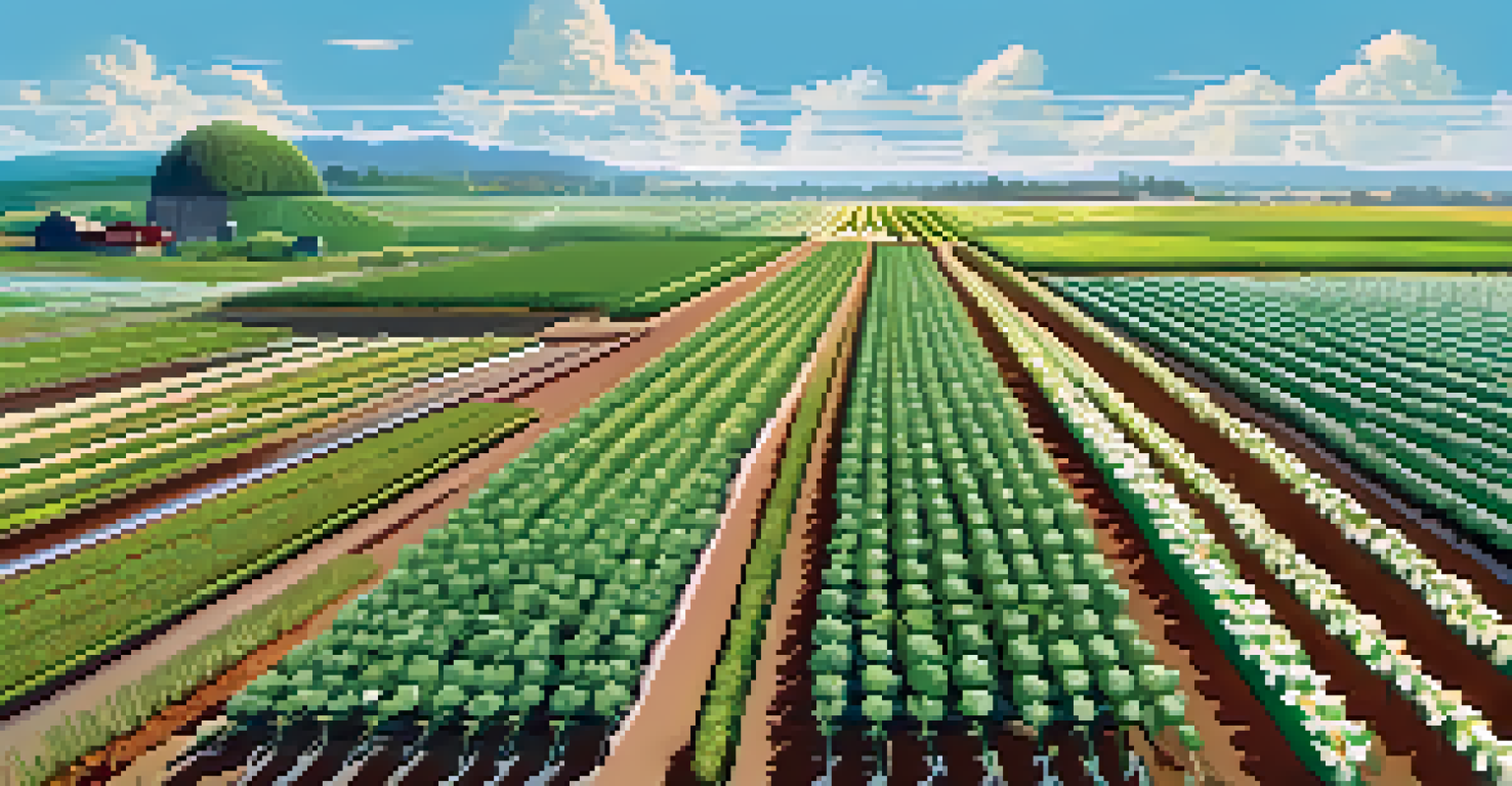Current Trends in Plant Genomics and Their Agricultural Implications

Emergence of CRISPR Technology in Plant Genomics
CRISPR technology has revolutionized the field of plant genomics by allowing precise edits to DNA. This technique enables scientists to enhance desirable traits in crops, such as drought resistance or increased yield. For example, researchers have successfully modified rice varieties to improve their nutritional value using CRISPR. As this technology becomes more accessible, it holds the potential to drastically improve food security globally.
Genetic engineering is not a separate science; it's a continuation of traditional breeding and a tool for farmers.
The beauty of CRISPR lies in its simplicity and efficiency; traditional breeding methods can take years, but CRISPR can achieve results in a fraction of the time. This fast-paced innovation can help farmers adapt to climate change and changing market demands more quickly than ever. However, the ethical implications of gene editing raise important discussions about food safety and biodiversity.
As we move forward, the integration of CRISPR in agriculture will likely lead to more sustainable farming practices. By understanding and manipulating plant genomes, we can create crops that require fewer resources, thereby lessening the environmental impact of agriculture. The exciting journey of CRISPR in plant genomics is just beginning, and its implications are boundless.
Advancements in Genomic Selection Techniques
Genomic selection is changing how we breed plants by using genomic data to predict the performance of traits in crops. This method allows breeders to select the best candidates for crossing before even planting them, significantly speeding up the breeding process. For instance, maize breeders can now identify superior lines more quickly, leading to better varieties that meet market needs.

The integration of big data analytics in genomics is another game changer. By analyzing vast datasets, breeders can better understand complex traits like disease resistance or yield potential. This not only improves the efficiency of breeding programs but also enhances the overall success rate of developing new varieties.
CRISPR Enhances Crop Traits
CRISPR technology allows precise genetic edits in plants, improving traits like drought resistance and nutritional value.
However, the challenge remains in implementing these advanced techniques in developing countries where resources are limited. By collaborating with local farmers and leveraging community knowledge, we can ensure that these innovations benefit everyone. The future of agriculture depends on how well we can harness these advancements and make them accessible to all.
The Role of Bioinformatics in Plant Genomics
Bioinformatics is crucial in plant genomics, as it helps in the analysis and interpretation of complex genetic data. With the rapid sequencing of plant genomes, bioinformatics tools are essential for making sense of the vast amount of information generated. For example, researchers can identify gene functions and interactions that play a significant role in crop development.
The future of food is not just about what we eat, but how we grow it.
These tools also facilitate the integration of genomic data with phenotypic information, leading to a more comprehensive understanding of plant traits. This holistic approach enables breeders to make informed decisions about which genetic traits to prioritize in their breeding programs. Ultimately, this can lead to the development of crops that are not only high-yielding but also resilient to environmental stresses.
As bioinformatics continues to evolve, it promises to make crop breeding more efficient and targeted. The future of agriculture lies in our ability to effectively harness these technologies, ensuring that we can produce enough food to feed a growing global population. The synergy between genomics and bioinformatics is a powerful force driving agricultural innovation.
Sustainable Agriculture Through Genetic Diversity
Genetic diversity is vital for sustainable agriculture, as it provides the resilience needed to withstand pests, diseases, and climate variability. Recent trends emphasize the importance of preserving heirloom and traditional varieties, which hold unique traits that can be beneficial for modern breeding programs. For example, some ancient grains are more resistant to drought, making them crucial for future food security.
Efforts are underway to incorporate this genetic diversity into mainstream crops through various breeding techniques, including genomic editing. By combining the best traits from diverse varieties, researchers are developing crops that are not only high-yielding but also more adaptable to changing environmental conditions. This approach aims to create a more resilient agricultural system.
Genomic Selection Streamlines Breeding
Genomic selection uses data to predict crop performance, speeding up the breeding process and enhancing efficiency.
Moreover, educating farmers about the benefits of genetic diversity can promote its adoption in farming practices. By growing a wider variety of crops, farmers can reduce their dependency on single crops and minimize risks. This holistic approach to agriculture ensures that we can maintain food production while preserving our natural ecosystems.
The Impact of Climate Change on Plant Genomics Research
Climate change poses a significant threat to agriculture, necessitating urgent research in plant genomics to develop climate-resilient crops. Scientists are working to understand how plants can adapt to extreme weather conditions, such as prolonged droughts or excessive rainfall. By identifying the genetic markers associated with these traits, researchers can breed plants that thrive in a changing climate.
For instance, studies have shown that certain genes can enhance a plant's ability to cope with heat stress, making them suitable for hotter regions. This knowledge allows breeders to select for these traits more effectively, ensuring that crops can withstand the pressures of climate change. The integration of climate data into genomic research is crucial for developing effective solutions.
As we face the challenges posed by climate change, the role of plant genomics will become increasingly vital. By investing in research and development, we can create a more sustainable agricultural landscape. This proactive approach will not only benefit farmers but also contribute to global food security in the long run.
Public Perception and Acceptance of Genetically Modified Crops
Public perception plays a crucial role in the adoption of genetically modified (GM) crops, often swaying policy decisions and market dynamics. Despite the potential benefits of GM technology, such as higher yields and reduced pesticide usage, misconceptions and fears persist among consumers. Educating the public about the safety and advantages of GM crops is essential to foster acceptance.
Transparency in the development and labeling of GM crops can also help address consumer concerns. For example, initiatives that promote open dialogue between scientists, farmers, and the community can bridge the gap and build trust. When people understand the science behind genetic modification, they are more likely to support its use in agriculture.
Genetic Diversity Supports Sustainability
Preserving genetic diversity in crops ensures resilience against climate change, pests, and diseases, promoting sustainable agriculture.
Moreover, as food security becomes a growing concern, the need for innovative solutions like GM crops becomes increasingly important. By aligning the messaging around the benefits of plant genomics with public concerns, we can create a more informed society. Ultimately, the success of agricultural biotechnology hinges on public acceptance and understanding.
Future Prospects of Plant Genomics in Agriculture
The future of plant genomics holds immense promise for agriculture, with ongoing innovations poised to address global challenges. As research continues to advance, we can expect breakthroughs that will enhance crop resilience, nutritional quality, and productivity. For instance, the development of crops with improved resistance to pests could significantly reduce the need for chemical pesticides, promoting eco-friendly practices.
Furthermore, the integration of artificial intelligence (AI) in genomics research is set to revolutionize how we approach breeding. By analyzing vast datasets, AI can identify patterns and predict which gene combinations will yield the best results. This synergy between technology and biology will lead to more targeted and efficient breeding programs.

As we look ahead, collaboration among scientists, farmers, and policymakers will be vital in harnessing the full potential of plant genomics. By working together, we can ensure that these advancements translate into tangible benefits for farmers and consumers alike. Embracing these innovations will pave the way for a sustainable and secure agricultural future.